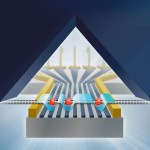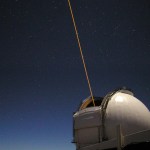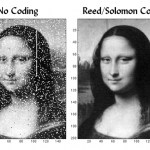Laser
Of the four new articles online on our website, three happen, purely by accident, to be on physics research. The three are very different, and yet each is an illustration of the ways that basic physics research changes our world – in small and large, practical and enlightening ways. And each is situated at a different intersection between the technological and the theoretical – a technological breakthrough that resulted from a successful attempt to provide proof for a theoretical construct, new inventions based on elementary physical principles of light, and a theory substantiated through a…
"But certainly the laser proved to be what I realized it was going to be. At that moment in my life I was too ignorant in business law to be able to do it right, and if I did it over again probably the same damn thing would happen." -Gordon Gould, inventor of the laser
You're used to the iconic image of an observatory's dome surrounded by a dark sky. From within, a telescope peers up at the heavens. And with a huge amount of light-gathering power that dwarfs a fully dilated human eye, we can use this tremendous tool to peek into the dark depths of the Universe.
Image credit: Fort Lewis…
The cultural critic Walter Benjamin, in his seminal 1936 essay The Work of Art in the Age of Mechanical Reproduction, argued that the "aura" of a work of art, that sense of special awe and reverence we feel, being in its presence, isn't inherent to art itself. Rather, it's a side-effect of its exclusivity, restricted exhibition, authenticity, or perceived value. With the age of "mechanical reproduction" (i.e. printed copies, films, and photographs), that aura disappeared, freeing art from its ties to the bourgeoisie and allowing mass audiences to, in a sense, "own" the work too. Take the Mona…
Every so often, real life intrudes on blogging, preventing the creation of fresh Insolence, at least Insolence of the quality that you've come to expect. This is one of those times. I happen to be sitting here in Palm Beach, Florida, but I'm not chilling at the beach or pool. Rather, I'm attending "leadership training." Yes, be very, very afraid! In any case, I never saw the point of having these sorts of training seminars at beautiful oceanfront locations if they're going to pack the entire day with, you know, actual training! Worse (for purposes of blogging), I really have to fine tune my…
Most of the time, when we talk about seeing quantum effects from light, we talk about extremely weak beams-- looking at intensities where one photon more or less represents a significant change in the intensity of the light. Last week, though, Physics Buzz wrote up a paper that goes in the other direction: they suggest a limit on the maximum strength of a laser pulse due to quantum effects, specifically the creation of particle-antiparticle pairs.
This is a little unusual, in that most of the time when people talk about really intense lasers, they end up discussing them as an oscillating…
Following on yesterday's discussion of the vacuum hardware needed for cooling atoms, let's talk about the other main component of the apparatus: the optical system. The primary technique used for making cold atoms is laser cooling, and I'm sure it will come as no surprise that this requires lasers, and where there are lasers, there must also be optics.
There are lots of different types of lasers used for laser cooling experiments, but they all need to have certain properties: tunability, stability, and adequate power. Tunability is important because laser cooling requires light at exactly…
Yes, green laser pointers are cool. Especially when you use them to make stuff fluoresce. Ok, what about a blue laser pointer? They are getting surprisingly cheap (Amazon has a 10 mW for pretty cheap). Still not cheap enough for me. But, you know what? Some of the physics majors here at Southeastern Louisiana University purchased a couple of these. Physics major Daniel let me borrow his.
First, they don't look too bright. This is probably because our eyes are not too sensitive to this wavelength. The blue 10 mW does not look anywhere near as bright as the 5 mW green that I used in…
So you have seen these color filters (or gels as they are also called). When you look through a red filter, everything looks red. What do they do to the light? I am not going to tell you the answer. However, I will show you some examples so that you can figure out the answer yourself.
In this video, I am going to use a red and a green laser pointer. The nice thing about laser pointers is that they essentially create only one color of light.
It is my duty as a blogger to mention lasers in this time of international laser celebration. This May is the 50th anniversary of the first lasers. Everyone knows a laser that they love, right? We all use them. So, instead of talking about lasers, I am going to post some great links to other laser stuff (including some of my stuff).
the history of the first lasers (AIP)
The above is the American Institute of Physics's presentation of the history of the laser. Really, this does a great job of giving all the details you would want. I highly recommend it.
Uncertain Principle's Laser…
Voting has closed on the Laser Smackdown poll, with 772 people recording their opinion on the most amazing of the many things that have been done with lasers in the fifty years since the invention of the first working laser (see the Laserfest web site for more on the history and applications of lasers). The candidates in the traditional suspense-building reverse order:
Lunar laser ranging 22 votes
Cat toy/ dog toy/ laser light show 41 votes
Laser guide stars/ adaptive optics 46 votes
Holography 47 votes
Laser eye surgery 53 votes
Optical storage media (CD/DVD/Blu-Ray) 60 votes
Laser…
We're just over 600 votes in the Laser Smackdown poll in honor of the 50th anniversary of the laser, as of early Friday morning. I notice that it has moved off the front page of the blog, though, so here's another signal-boosting repost, just so we have as many votes as possible, to establish maximum scientific validity when we declare the winner the Most Amazing Laser Application of All Time
Which of the following is the most amazing application of a laser?Market Research
Voting will remain open until next Sunday, May 2, just two days from now, with the ultimate winner announced on Monday…
As of 1:45 Monday, 217 people have cast votes in the Laser Smackdown poll. That's not bad, but it's currently being handily beaten by the 271 people who have voted for a favorite system of units.
The nice thing about using actual poll services for this sort of thing, though, is that I can re-post the poll to boost signal a little. So, here it is again, a list of the twelve most amazing laser applications suggested by my wise and worldly readers, with links to short explanations of the pros and cons of each:
Which of the following is the most amazing application of a laser?Market Research…
What's the application? Producing artificial "stars" to serve as a reference for telescopes using adaptive optics to correct for atmospheric turbulence. This allows ground-based telescopes to produce images that are as good as those from the Hubble Space Telescope.
What problem(s) is it the solution to? "How can I make this giant telescope produce even more impressive pictures?"
How does it work?The basic problem with ground-based telescopes, as anyone who has ever looked at the stars or listened to nursery rhymes can tell you, is that stars "twinkle." They appear to fluctuate in brightness…
What's the application? An optical frequency comb is a short-duration pulsed laser whose output can be viewed as a regularly spaced series of different frequencies. If the pulses are short enough, this can span the entire visible spectrum, giving a "comb" of colored lines on a traditional spectrometer. This can be used for a wide variety of applications, from precision time standards to molecular spectroscopy to astronomy.
What problem(s) is it the solution to? 1) "How do I compare this optical frequency standard to a microwave frequency standard?" 2) "How do I calibrate my spectrometer well…
What's the application? Using lasers to cut and/or cauterize tissue during surgical procedures, instead of the traditional very small very sharp knives.
What problem(s) is it the solution to? 1) "How can we do surgery without touching the tissues being operated on?" 2) "How can I get rid of these annoying glasses/contact lenses?"
How does it work? First, you strap a device to your head that lets you shoot laser beams from your forehead, like one of the X-Men. then you use a magnifying glass to focus it to where it needs to be. Like so:
(I'm not sure exactly what sort of procedure that is,…
What's the application? The goal of laser ignition fusion experiments is to heat and compress a target to the point where the nuclei of the atoms making up the sample fuse together to form a new, heavier nucleus, releasing energy in the process. Nuclear fusion is, of course, what powers stars, and creating fusion in the laboratory has been the holy grail (well, a holy grail, at any rate) of nuclear physics research for the last sixty-plus years.
What problem(s) is it the solution to? 1) "Can we create fusion reactions in a laboratory setting on Earth?" 2) "How can we get more helium without…
What's the application? Holograms are images of objects that appear three-dimensional-- if you move your head as you look at a hologram, you will see the usual parallax effects, unlike a normal photograph, which is fixed. So, if your hologram includes one object that is partly behind another object, you can see around the obstruction by moving a bit to the side, just as you would if the original objects were in front of you.
What problem(s) is it the solution to? 1) "How can we jazz up flat images and make them look more lifelike?" 2) "How can we make credit cards harder to copy?"
How does it…
What's the application? Optical tweezers use focused light beams to trap small particles in the focus of the beam, and drag them around by moving the beam.
What problem(s) is it the solution to? 1) "How do we move these tiny little things around without touching them?" 2) "How do we measure the forces exerted by biological molecules?" 3) "How do we tie knots in DNA strands?"
How does it work?The basic optical tweezer scheme uses a single beam of light focused down to a very small spot. If you take some small (mostly) transparent object and place it in the beam, it will feel a force pulling it…
What's the application? Using lasers to reduce the speed of a sample of atoms, thereby reducing their temperature to a tiny fraction of a degree above absolute zero.
What problem(s) is it the solution to? 1) "How can I make this sample of atoms move slowly enough to measure their properties very accurately?" 2) "How can I make this sample of atoms move slowly enough for their quantum wave-like character to become apparent?"
How does it work? I've written about laser cooling before, but the nickel version of the explanation is this: You can think of a beam of light as being made up of photons…
What's the application? The use of lasers to provide an entertaining light show for humans, dogs, or cats.
What problem(s) is it the solution to? 1) "How will I entertain my dog or cat?"
2) "How can we distract people from the fact that Roger Daltrey has no voice left?"
Why are lasers essential? Lasers provide coherent beams of light, which remain small over very large distances, allowing you to project a small spot or a tight beam across a room, or even a football stadium.
Why is it cool? Duuuuude! Lasers, duuuuude!
Why isn't it cool enough? 1) It's fundamentally just a toy. 2) No amount…


